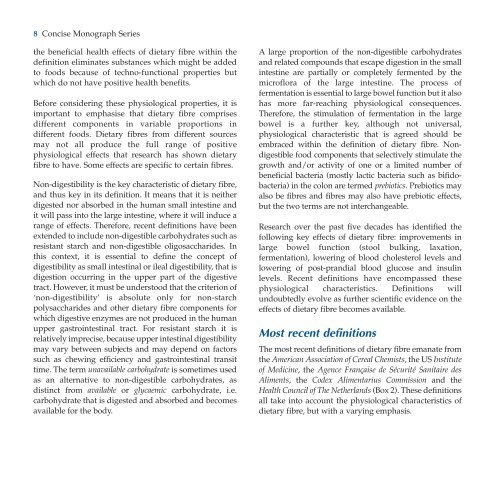Dietary Fibre - ILSI Argentina
Dietary Fibre - ILSI Argentina
Dietary Fibre - ILSI Argentina
Create successful ePaper yourself
Turn your PDF publications into a flip-book with our unique Google optimized e-Paper software.
8 Concise Monograph Series<br />
the beneficial health effects of dietary fibre within the<br />
definition eliminates substances which might be added<br />
to foods because of techno-functional properties but<br />
which do not have positive health benefits.<br />
Before considering these physiological properties, it is<br />
important to emphasise that dietary fibre comprises<br />
different components in variable proportions in<br />
different foods. <strong>Dietary</strong> fibres from different sources<br />
may not all produce the full range of positive<br />
physiological effects that research has shown dietary<br />
fibre to have. Some effects are specific to certain fibres.<br />
Non-digestibility is the key characteristic of dietary fibre,<br />
and thus key in its definition. It means that it is neither<br />
digested nor absorbed in the human small intestine and<br />
it will pass into the large intestine, where it will induce a<br />
range of effects. Therefore, recent definitions have been<br />
extended to include non-digestible carbohydrates such as<br />
resistant starch and non-digestible oligosaccharides. In<br />
this context, it is essential to define the concept of<br />
digestibility as small intestinal or ileal digestibility, that is<br />
digestion occurring in the upper part of the digestive<br />
tract. However, it must be understood that the criterion of<br />
‘non-digestibility’ is absolute only for non-starch<br />
polysaccharides and other dietary fibre components for<br />
which digestive enzymes are not produced in the human<br />
upper gastrointestinal tract. For resistant starch it is<br />
relatively imprecise, because upper intestinal digestibility<br />
may vary between subjects and may depend on factors<br />
such as chewing efficiency and gastrointestinal transit<br />
time. The term unavailable carbohydrate is sometimes used<br />
as an alternative to non-digestible carbohydrates, as<br />
distinct from available or glycaemic carbohydrate, i.e.<br />
carbohydrate that is digested and absorbed and becomes<br />
available for the body.<br />
A large proportion of the non-digestible carbohydrates<br />
and related compounds that escape digestion in the small<br />
intestine are partially or completely fermented by the<br />
microflora of the large intestine. The process of<br />
fermentation is essential to large bowel function but it also<br />
has more far-reaching physiological consequences.<br />
Therefore, the stimulation of fermentation in the large<br />
bowel is a further key, although not universal,<br />
physiological characteristic that is agreed should be<br />
embraced within the definition of dietary fibre. Nondigestible<br />
food components that selectively stimulate the<br />
growth and/or activity of one or a limited number of<br />
beneficial bacteria (mostly lactic bacteria such as bifidobacteria)<br />
in the colon are termed prebiotics. Prebiotics may<br />
also be fibres and fibres may also have prebiotic effects,<br />
but the two terms are not interchangeable.<br />
Research over the past five decades has identified the<br />
following key effects of dietary fibre: improvements in<br />
large bowel function (stool bulking, laxation,<br />
fermentation), lowering of blood cholesterol levels and<br />
lowering of post-prandial blood glucose and insulin<br />
levels. Recent definitions have encompassed these<br />
physiological characteristics. Definitions will<br />
undoubtedly evolve as further scientific evidence on the<br />
effects of dietary fibre becomes available.<br />
Most recent definitions<br />
The most recent definitions of dietary fibre emanate from<br />
the American Association of Cereal Chemists, the US Institute<br />
of Medicine, the Agence Française de Sécurité Sanitaire des<br />
Aliments, the Codex Alimentarius Commission and the<br />
Health Council of The Netherlands (Box 2). These definitions<br />
all take into account the physiological characteristics of<br />
dietary fibre, but with a varying emphasis.

















